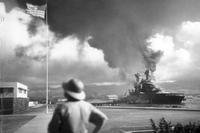MOBILE, Ala. -- The Navy and Austal USA held a keel laying ceremony for the future USS Montgomery, the Navy's eighth littoral combat ship (LCS), June 25, in Mobile, Ala.
The keel-laying ceremony recognizes the first joining together of a ship's components. While modern shipbuilding processes allow fabrication of individual modules to begin months earlier, keel laying represents the formal beginning of a ship.
Ship sponsor Mary Sessions, wife of Alabama Sen. Jeff Sessions, authenticated the keel by having her initials welded into a sheet of the ship's hull.
The LCS is a new breed of U.S. Navy warship, capable of open-ocean operation but optimized for littoral, or coastal, missions. Montgomery is one of four Independence-variant LCS currently under construction at Austal USA. The ship is expected to deliver to the fleet in 2016.
"This class of ships breaks new ground in Navy acquisition, ship design and warfighting technology," said Capt. Stephen Mitchell, supervisor of Shipbuilding, Gulf Coast. "I am impressed by their strength, flexibility and extraordinary capability, and they offer our troops a greater range of options than ever before."
The Navy is committed to the LCS program and is leveraging competition, fixed-price contracting and ongoing production to reduce construction time and costs. Lessons learned from the lead ships have been incorporated in the follow on ships.
"It is exciting to see the shipyard really getting into the rhythm of serial production," said Capt. Tom Anderson, LCS program manager.
Although several vessels have been named USS Montgomery, LCS 8 is only the second U. S. Navy ship named specifically for the city of Montgomery, Ala. The former cruiser USS Montgomery (C 9) was commissioned in 1894 and decommissioned in 1918. The ship primarily operated in the Caribbean and off the coast of South America, participating in the blockade of Havana, Cuba, in 1898 during the Spanish-American War.
PEO LCS is responsible for delivering and sustaining credible littoral mission capabilities to the fleet and is working with industry to achieve steady production to increase production efficiencies and leverage cost savings. Delivering high-quality warfighting assets while balancing affordability and capability is key to supporting the nation's maritime strategy.


























